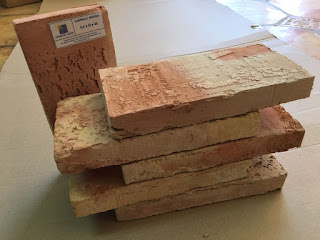 Sebastian Perez, HandmadeTerracotta Bricks are one of the best Natural Construction Material for the construction of Eco-Friendly & Cost-Effective Buildings .
Sebastian Perez, HandmadeTerracotta Bricks are one of the best Natural Construction Material for the construction of Eco-Friendly & Cost-Effective Buildings .
A clay brick is a traditional masonry construction element. It may be
solid or perforated and may be used for building or paving.
Terracotta/earthenware was the only known type of ceramic produced by Western and pre-Columbian people until the 14th century, when imported European fired stoneware began production. Terracotta has been used throughout history for sculpture and pottery as well as for bricks and roof shingles. In ancient times, the first clay sculptures were dried (baked) in the sun after being formed. They were later placed in the ashes of open hearths to harden, and finally kilns were used, similar to those used for pottery today. However, only after firing to high temperature would it be classed as a ceramic material.
These bricks are used in load-bearing walls, partition walls, facing,
ceilings and floors. Solid bricks offer good thermal properties, load
bearing capacities and compressive strength.
 Solid clay brick offers several advantages over other structural
materials. It has very high compressive strength, requires no formwork,
its constituent materials are widely available and its manufacture is
less damaging to the environment than the production of concrete. A clay
brick may be produced in different ways. It is molded and may be fired
or naturally air dried.
Solid clay brick offers several advantages over other structural
materials. It has very high compressive strength, requires no formwork,
its constituent materials are widely available and its manufacture is
less damaging to the environment than the production of concrete. A clay
brick may be produced in different ways. It is molded and may be fired
or naturally air dried.
Architectural terracotta refers either to decorated ceramic elements such as antefixes and revetments, usually brightly painted, which made a large contribution to the appearance of temples and other buildings in the classical architecture of Europe, as well as in the Ancient Near East, or to forms of ceramic skins used to surface buildings from the 19th century onwards. In the latter sense unglazed architectural terracotta became fashionable as an architectural ceramic construction material In Spain in the 1570s, in England in the 1860s, and in the United States in the 1870s.

Terracotta had the advantage of being cheap and light. It was adaptable to mass-production techniques for stock shapes, although the plaster moulds had a limited capability for re-use. Additionally it could be freely worked by craftsmen to make custom-sculptured adornments and plaques. It was accepted as a material by the Arts and Crafts movement because despite seeming a mass-produced material it was handmade and designed by craftsmen. It had a manufacture time of about eight weeks and each piece had to be made over-size to allow for shrinkage as the clay body dried. To avoid cracking the pieces had to be quite thin.


Today many people that are building their
houses choose to use eco-friendly building materials. An eco-friendly
building material increases the efficiency of energy used and reduces
impact on human well-being and the environment. Of all the material used
during construction, one often ignores the value of using the right
brick. If you are looking for a brick that is eco-friendly and
cost-effective than I would suggest you could go for hollow brick.




















